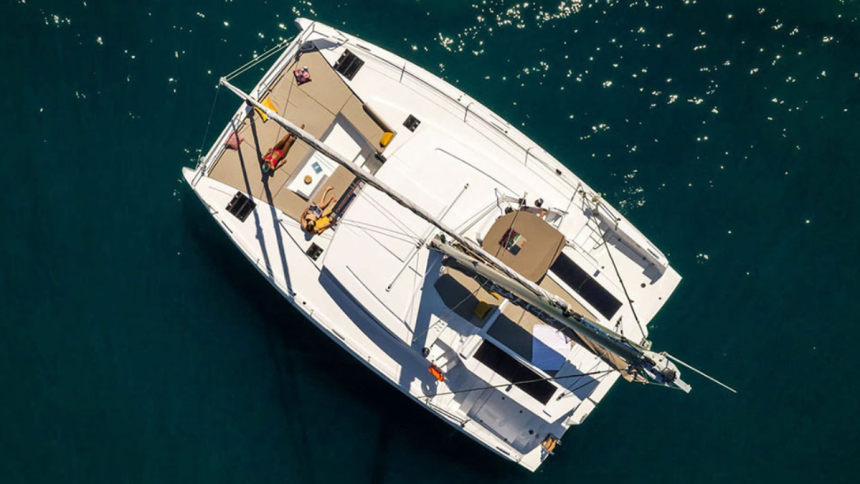You step onto a sun-warmed deck, feel a salt-sweet Pacific breeze brush your cheek, and spot the granite outline of The Arch on the horizon. In minutes the skipper lifts the lines, twin hulls glide ahead, and the boat stays level enough to balance a latte. This primer demystifies private catamarans, breaks down basic maneuvers, and explains why Cabo’s forgiving seas form the perfect classroom for first-time sailors.
Catamaran vs. Monohull: The Physics Made Simple
Two hulls equal twice the stability. Picture a low-slung bridge connecting parallel floats; wave energy disperses outward rather than jolting a single keel. Wide beams reduce heel angle, so toddlers can toddle and gear stays dry. Because buoyancy is spread across more surface area, catamarans draft shallow water, letting you nose closer to shorelines that monohulls skirt. A private catamaran also carries engines in each hull, giving pilots extra steering muscle during tight marina turns.
Why Cabo Is the Perfect Classroom
Cabo sits at the tip of the Baja Peninsula where the Pacific meets the Sea of Cortez. Mountains block strong northerlies, and every sunrise ignites gentle land breezes that flatten chop. Learners absorb new skills quickly without seasick distractions, and water clarity teases coral gardens just beneath the trampolines. From January through May the temperature hovers near 25 °C, so practice sessions never feel like survival drills.
Essential Parts of Your Floating Classroom
- Helm: steering wheel or joystick that controls rudders
- Flybridge: elevated lounge for panoramic sightlines
- Trampoline nets: woven mesh between bows that doubles as sunbed
- Daggerboards: retractable fins for upwind grip
- Sheet winches: drums that tension sail lines
Safety Gear Snapshot
Life jackets sized to every torso, fixed VHF radio linked to Cabo Port Authority, and reef-safe sunscreen top the must-bring list. Many charter companies email a PDF checklist once you reserve.
First Dock-to-Sea Drill: Leave the Marina Like a Pro
- Cast off lines bow to stern, confirming fenders are clear.
- Engage engine controls at idle, check both prop wash zones.
- Use gentle thruster taps to pivot 90 ° before shifting forward.
- Maintain walking speed until channel buoy, then raise mainsail once clear.
Twin screws placed far apart allow a private catamaran to spin in its own length, a welcome trick when neighboring slips brim with sport-fishers.
Plotting the Iconic Course to The Arch
Set a heading of 210 ° out of Cabo San Lucas marina, then bear starboard once you clear the outer breakwater. Currents flow mild, but slack tide offers the calmest surface for photos. Sea lions cluster on nearby rocks, while pelicans dive-bomb sardine shoals. As you approach The Arch, keep engines neutral and drift within the legally permitted buffer so granite fills the frame without startling wildlife.
Quick Helm Commands Cheat Sheet
- “Head up”: point closer to wind
- “Bear away”: fall off the wind
- “Sheet in”: pull sail tighter for power
Anchoring & Beach Hop: Lover’s vs. Divorce
Just east of The Arch, Lover’s Beach offers sandy hold at five metres. Drop anchor, reverse at minimal throttle to set, and snorkel into crystalline shallows. On the Pacific side, aptly named Divorce Beach flaunts stronger rip currents; admire from deck rather than diving in. Keep watch on depth sounder since sandbars shift after winter storms.
Basic Sail Trim: Catch Cabo’s Afternoon Breeze
Tell-tales, those little ribbons on the jib, reveal airflow. Tight line = tight ride, so winch until windward ribbons flutter aft and leeward lie flat. Ease mainsheet if weather helm grows heavy; catamarans accelerate rapidly when both sails cooperate, yet they also forgive late adjustments thanks to their balanced platform.
Eco-Best Practices on the Baja Blue
Solar panels often blanket cabin tops, powering fridges and nav lights and cutting generator emissions. Swap single-use bottles for refillable flasks and stow trash until returning to port. A third call-out: choose a private catamaran outfitted with low-friction hull paint that reduces fuel burn and protects delicate reef zones.
Troubleshooting in Calm & Chop
- Engine restart: shift to neutral, wait three seconds, then press start for each side.
- MOB drill: point at victim, kill engines, deploy throwable flotation, approach from downwind.
- Re-orient using landmarks: if haze rolls in, steer toward The Arch silhouette until GPS signal stabilises.
Conclusion
Twin hulls cut silent paths across turquoise glass as Cabo’s cliffs glow amber behind you. Master the basics, set your own compass, and let Cabo teach the rest. A weekend of patient tutelage on calm water is often all it takes to graduate from passenger to confident crew, and the horizon past The Arch waits for your next course adjustment.
Lynn Martelli is an editor at Readability. She received her MFA in Creative Writing from Antioch University and has worked as an editor for over 10 years. Lynn has edited a wide variety of books, including fiction, non-fiction, memoirs, and more. In her free time, Lynn enjoys reading, writing, and spending time with her family and friends.















